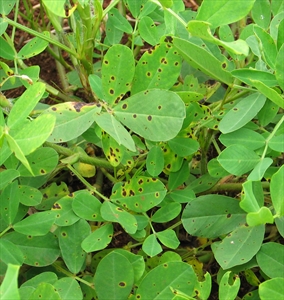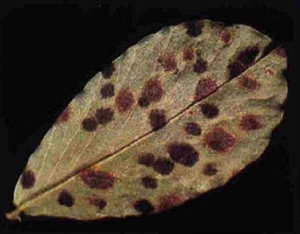Peanut leaf spots, early and late leaf spots of peanuts (groundnuts)
Pacific Pests, Pathogens, Weeds & Pesticides - Online edition
Pacific Pests, Pathogens, Weeds & Pesticides
Peanut leaf spots (036)
Mycosphaerella arachidis (early leaf spot) and Mycosphaerella berkeleyi (late leaf spot). These are the names of the fungus that produce sexual spores. Where only asexual spores are present, the fungus is known as Passalora (Cercospora) arachidicola and Passalora (Cercosporidium) personatum, respectively.
Both are found worldwide: Asia, Africa, Nother, South and Central America, the Caribbean, Oceania. Early leaf spot is recorded from Australia, Fiji, New Caledonia, Papua New Guinea, Solomon Islands. Late leaf spot is recorded from Australia, Fiji, French Polynesia, Guam, New Caledonia, Papua New Guinea, Solomon Islands, and Tonga.
Peanuts, and other plants belonging to the genus Arachis.
It is difficult to tell the two leaf spot diseases apart, except that one appears later than the other. Early leaf spot is supposed to have a more obvious yellow margin around the brown spots (Photo 1), but this is not always the case. Late leaf spot is black rather than brown on the underside of the leaf, but this is not always obvious (Photos 2&3, except when they occur together (Photo 4). Examination of the spores under a microscope is needed to tell the fungi apart.
The first sign of the diseases are spots on the older leaves. These spread rapidly to leaves of all ages. Spots also occur on the petioles. The brown or red-brown leaf spots are roughly circular up to 10 mm diameter - usually smaller - often with a yellow margin. The spots are darker on the under surface of the leaf.
Masses of spores are produced on the spots, but a hand lens is needed to see them. These are spread by wind and rain splash. The spores germinate in water on the leaf surface, infect and produce more spots and spores. The life cycle takes 10-14 days. The fungi survive in crop remains.
These are serious diseases that occur in most places where peanuts are grown. Infection causes early death of the leaves and yield loss. It is not known what losses these diseases cause in Pacific island countries, but it is likely that they reduce yields by 50%, probably much more.
Inspect plants regularly, at least once a week, looking for spots, especially on the older leaves, where infections first occur.
CULTURAL CONTROL
Cultural control is important. The following should be done:
Before planting:
- Leave at least 1 year between crops planted on the same land, so that the remains of the old crop decompose before another crop is planted.
- Plant new crops as far away as possible from old crops, especially those with leaf spots.
- If it is not possible to avoid planting near old crops, do not plant downwind from them; otherwise, spores will easily spread to the new crop in wind and rain.
- Remove any volunteer plants from the last crop.
During growth:
- Inspect the crop at least once a week, and if growing the crop for sale, spray as soon as leaf spots are seen in the crop.
After harvest:
- Collect and burn or bury the remains of the crop.
RESISTANT VARIETIES
There are breeding programs at ICRISAT, the International Crops Research Institute for the Semi-Arid Tropics, the US and Australia, to produce varieties with tolerance to late leaf spot and also rust disease. One such variety from Australia is Sutherland. Several varieties have been imported by Papua New Guinea and Solomon Islands in recent years. Enquire whether these new varieties are available in your country.
CHEMICAL CONTROL
In most instances, chemical control is required if growers are producing for the market. Do the following:
- Carry out regular inspections.
- Spray as soon as spots are seen, even if they appear only on one or a few plants.
- Spray regularly: 10-14 days is best, continuing until 14 days before harvest.
Use chlorothalonil. It controls leaf spots and also rust disease (see Fact Sheet no. 34). Copper fungicides can also be used.
Spray more often if:
- The first treatment is late and there are many plants with spots. In most cases, spraying should begin no later than 30-35 days after planting.
- Rainfall is high and control is poor.
____________________
When using a pesticide, always wear protective clothing and follow the instructions on the product label, such as dosage, timing of application, and pre-harvest interval. Recommendations will vary with the crop and system of cultivation. Expert advice on the most appropriate pesticide to use should always be sought from local agricultural authorities.
AUTHORS Helen Tsatsia & Grahame Jackson
Information from Shew B (2020) Peanut leaf spots. NC Extension.(https://content.ces.ncsu.edu/early-leaf-spot-of-peanut-1#:~:text=Peanut%20leaf%20spots%20are%20caused,arachidicola)%20causes%20early%20leaf%20spot.); and GRDC (undated) Managing leaf diseases in peanuts. Queensland Government. (https://grdc.com.au/__data/assets/pdf_file/0030/207687/managing-leaf-disease-in-peanuts.pdf.pdf); and Damicone JP (2017) Foliar diseases of peanuts. Oklahoma State University. (https://extension.okstate.edu/fact-sheets/foliar-diseases-of-peanuts.html); and from (including Photo 4) McKenzie E (2013) Passalora arachidicola and Passalora personata - (http://www.padil.gov.au).
Produced with support from the Australian Centre for International Agricultural Research under project PC/2010/090: Strengthening integrated crop management research in the Pacific Islands in support of sustainable intensification of high-value crop production, implemented by the University of Queensland and the Secretariat of the Pacific Community.







